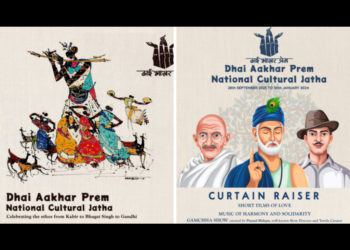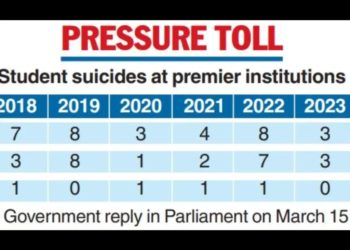
"A man can be as truly a Hindu as any without believing in the Vedas as an independent religious authority."
-V.D.Savarkar , Hindutva : Who is a Hindu? (1923)
While defining the concept of Hindutva, the political and cultural difference with Hinduism is one of the main planks for the reiteration of the national identity. At the same time, Hindutva shares a deeply complex relationship with not only the way in which it uses Hinduism for its political ends but also in the manner in which Hinduism itself has evolved since the 19th century. Being the fountainhead of Hindutva ideology, Savarkar's case serves as an archetypal example of this vexed relationship between Hindutva and Hinduism.
Even as the above mentioned quote from his book underscores his staunch Atheism, it still leaves marked ambiguities. These ambiguities move much beyond the simple characterisation of them being a form of political opportunism. For instance, the same book glorifies the notion of Hindu Rashtra as a ‘sacred nation’ (Jaffrelot, 2007). This sacredness is derived from the Sanskrit word Aryavarta, as has been explained in the Vedas. Therefore, the religious sanction to political Hinduness is central to Hindutva thought. The more celebrated classification of Punyabhoomi and Pitrubhoomi can also be argued to have religious connotation. This can further be illustrated by situating the Hindutva idea of national identity into three connected pillars – geographical unity, racial features and common culture.
Savarkar's recourse to the Bhagavad Gita is another significant example of reliance on a religious text for providing an ethical premise for violence against Non-Hindus (Bhatt, 2000). He is a strong votary of ‘action with knowledge,’ an idea that again has its roots in his reading of the Bhagavad Gita. This acts as the basic precept of his ideology for the realization of the Hindu nation.
Savarkar believes this project has not been fulfilled due to the polytheistic nature of Hinduism. He strongly believes that Hinduism lacks a sense of history and is devoid of the use of reason which was fostered by the monotheistic character of Christianity. He was not particularly averse to the everyday rituals and beliefs of Hinduism but believed that there is a need to incorporate secular principles into the religion. The eventual universalization of 'organised religion' takes its inspiration from the dynamic of secularization and proselytization of the variants of Christian theology. (Copley, 2003)
Savarkar deployed language in a somewhat contradictory manner. He argued that Sanskrit and the omniscience of past glory must be complimented by an overarching spread of Hindi. He saw vernacular languages as a hinderance to the continuum of sacred thought. However in order to contruct the origins of the vernaculars are encouraged (Deshpande, 2009).
"The day when the horse of Viceroy returned to Ayodhya unchallenged and unchallengeable, the great white umbrella of Sovereignty was unfurled over that imperial throne of Ramachandra, the brave, Ramachandra the good, and a loving allegiance to him was sworn, not only by the princes of Aryan blood but Hanuman, Sugriva, Bibishana and from the south – that day was the real birth-day of our Hindu people. It was truly our national day; for Aryans and Anaryans knitting themselves into a people were born as a nation." (emphasis added)
Furthermore, the Hindu nation is also identified by Savarkar in religious epics like the Ramayana in his seminal text on Hindutva. Savarkar's atheism does not seem to pose a hindrance to his attempt at seeking political legitimacy from a religious epic. The distinctly religious principle of self-consciousness as a mode of being and not a mode of knowing, shares parallels with Hindutva. This idea is further entrenched by the way Savarkar envisions the role historical wars have played in shaping this consciousness. Interestingly, while he refuses to acknowledge any religious element in ancient wars, religion is seen as a central and demonic characteristic of the alien Islamic invaders. The religion is deftly used for othering alien communities. This othering is not possible unless and until the sacredness of Motherland is underscored. Thus Hindu Rashtra's territorial and cultural landscape fails to escape the religious cartography of the 'civilizational ethos'. Ironically, detachment from Hinduism for Hindutva has to happen from within Hinduism itself.
Situating Savarkar and the larger Hindutva world view within a historical context, reveals the convoluted relationship between Hindutva and Hinduism. Hindutva's insistence on a single, common culture can be traced to the idea of romantic nationalism which was championed by philosophers like Herder and Fichte (Bhatt, 2001; Chaturvedi 2013). Racial features as another component of Hindutva finds similarities with the idea of the Volkisch. How can the idea 'religio-nativism' which arose in the West be understood in the Indian context? Is it a precursor to the nationalist movement or a consequence of the inherent nature of religion in the Indian subcontinent? For this 'religious nationalism' needs to be seen as a region specific phenomenon. Some scholars have argued for the usage of a much aggressive term, fundamentalism to characterise this development (Gold, 1996). This is further complicated when the category of 'religion' is understood as a foreign category (Balagangadhara, 2010).
The reconstruction of Hinduism in the 19th century has to be juxtaposed with the rise of the Hindutva narrative in the late 19th century. Interestingly, the idea of the organic unity of Hinduism is an equally vital element for both the reformist and revivalist schools of thought. The idea of refashioning Hinduism as monotheistic was cetnral to the process of reconstruction. Hindusim as a conglomeration of sects was seen as both unbecoming of a powerful religion as well as a signifier of effeminacy. Therefore reactive nature of Hindutva coincides with an equally reactive emergence of Hinduism in the 19th century. Can we also say that the Hindu reformist organisations of 19th century and their emergence essentially from being reactive to the missionary conceptualising of Hinduism, is also not related to the 'original' idea of Hinduism?
This emergence of religious reformism and revivalism in the 19th century can arguably both be termed as Brahminical Hinduism. Caste plays an important role in the use of ideas like dharma, seva and bhakti which in turn played a significant role in the dissemination of Hindutva. Their prevalence cannot be overemphasised even in contemporary times by the way in which they are used by Hindu nationalist organisations like the Rashtriya Swayamsevak Sangh. This is another important similarity that cannot be overlooked – the centrality of caste to the functioning of both Hinduism and Hindutva. Another example of the role of caste is the cow protection movement of the late 19th century. The Anti-Brahmin movement, too in a reverse sense, tended to solidify the relationship between Hindutva and Hinduism.
Moving beyond the linear hypothesis of religion being used for the sinister purpose of communal polarisation, religion must be seen as a phenomenon that has constantly depended on the evolving structures of political economy to stay relevant. Community as a political agent can be seen in the spread of Vaishnavism, especially in the writings of the Bengali literary giant, Bhartendu Harishchandra (Dalmia, 2010). The Vaishnava traits in the Hindu Nationalism of the Hindi heartland can be seen even in contemporary times. One reason for this is that Vaishnavism is seen as having a historical underpinning unlike the more monist and philosophical moorings of Shaivism (Pinch, 1996).
A recent scholarly work on 'Rashtriya Kirtan' which poses layered conceptions of intimacy between Dharma and Power (Anna Schulz, 2012) requires similar interventions in the complex interface of politics and religion. The broader question is not whether they directly propagate Hindutva sentiments, but rather who exactly were in a position to realise its wider ideological ambits through the prism of religion.
References :
Balagangadhara, S.N (2008) : "Orientalism, postcolonialism and the 'construction' of religion" In Rethinking Religion in India- The Colonial Construction of Hinduism , edited by Esther Bloch, Marianne Keppens and Rajaram Hegde, 135-164 : Routledge.
Bhatt, Chetan (2001) : Hindu Nationalism – Origins, Ideologies and Modern Myths : Berg Publishers.
Chatterjee, Partha (1993) : The Nation and its Fragments – Colonial and Postcolonial Histories : Princeton University Press.
Chaturvedi, Vinayak (2013) : "Rethinking Knowledge with Action : V.D.Savrkar, the Bhagavad Gita and Histories of Warfare" In Political Thought in Action – The Bhagavad Gita and Modern India, edited by Shruti Kapila and Faisal Devji, 155-177 : Cambridge University Press.
Copley, Antony (2003) : "Introduction – Debating Hindu Nationalism and Hindu Religious Belief" In Hinduism in Public and Private – Reform, Hindutva, Gender and Sampraday, edited by Antony Copley, 1-31 : Oxford University Press.
Dalmia, Vasudha (2009) : "The Only Real Religion of the Hindus : Vaishnava Self- representation in the Late Nineteenth Century" In The Oxford India Hinduism Reader, edited by Vasudha Dalmia and Heinrich Von Stietencron , 90-129 : Oxford University Press.
Deshpande, G.P (2009) : The World of Ideas in Modern Marathi : Tulika Publishers.
Jaffrelot, Christopher (2007) : Hindu Nationalism – A Reader : Permanent Black.
Pinch, William (1996) : "Soldier Monks and Militant Sadhus" In Making India Hindu, edited by David Ludden, 140-162 : Oxford University Press.
Savarkar, Veer Damodar (1923) : Hindutva – Who is a Hindu ?
Schulz, Anna (2012) : Singing a Hindu Nation – Marathi Devotional Performance and Nationalism : Oxford University Press.
Veer, Peter Van Der (1994) : Religious Nationalism – Hindus and Muslims in India : University of California Press.




